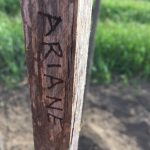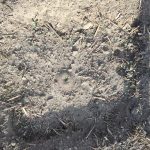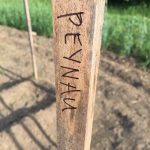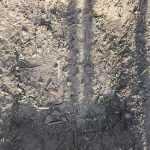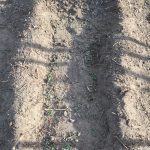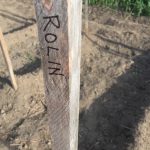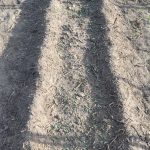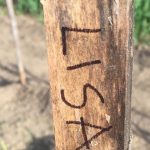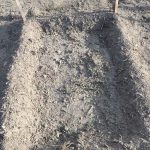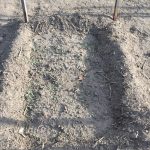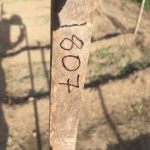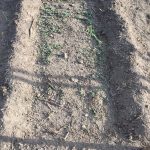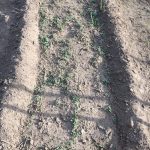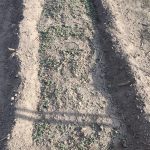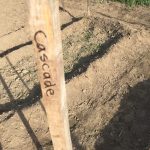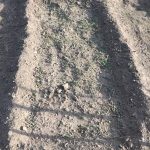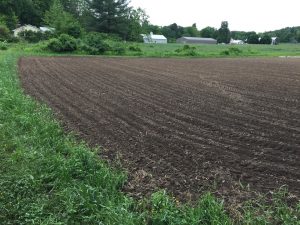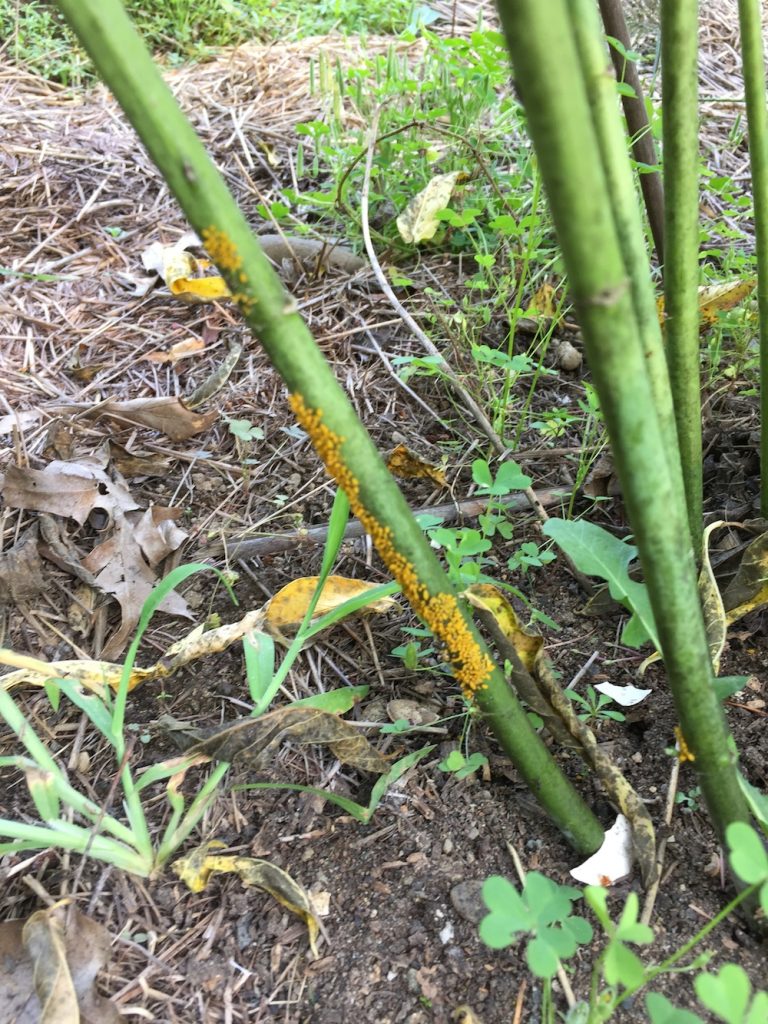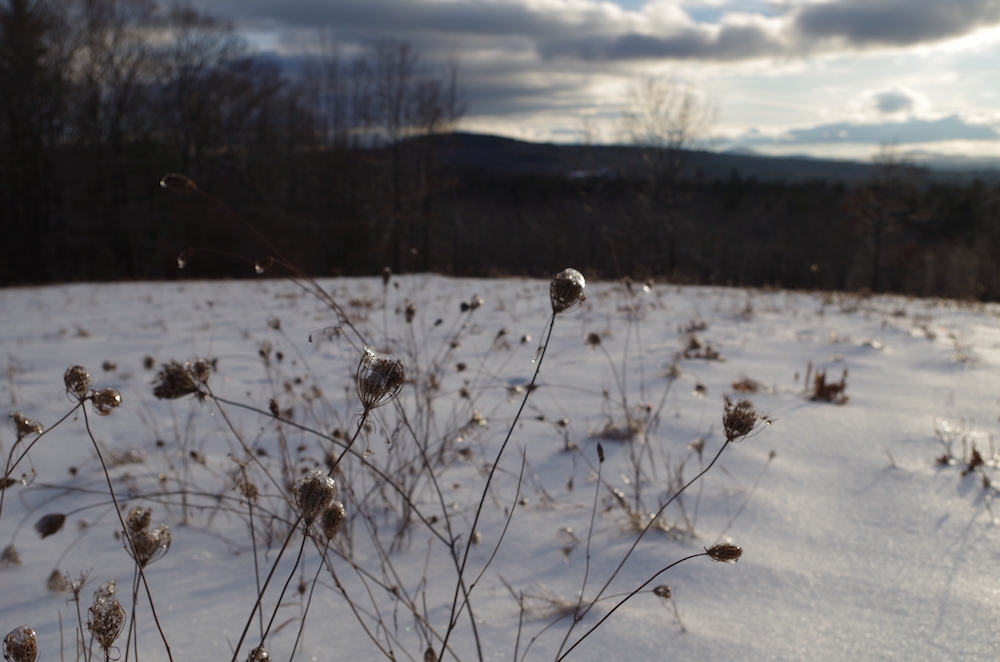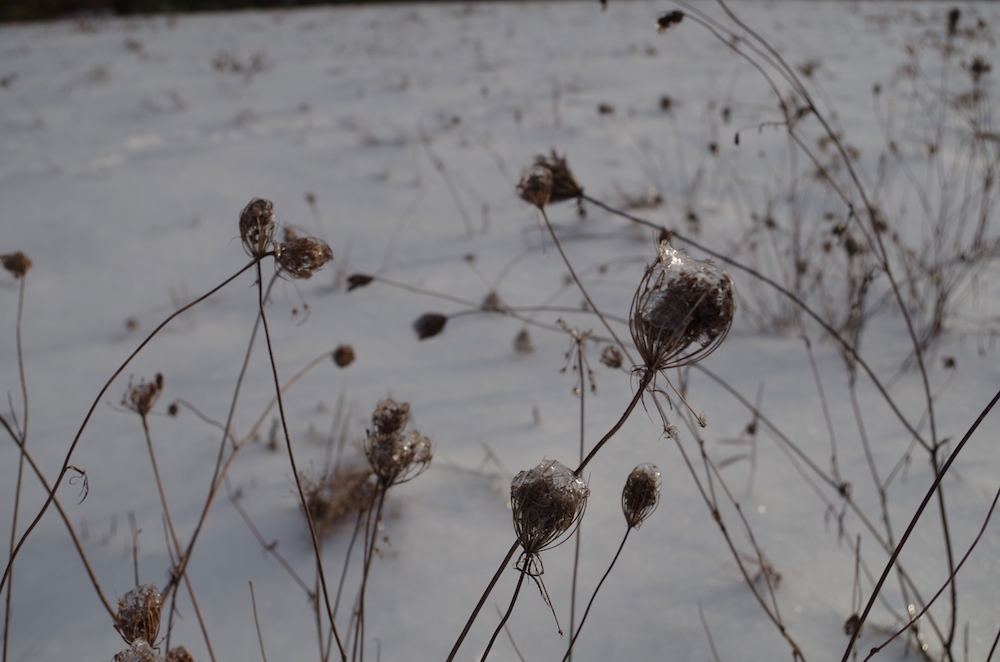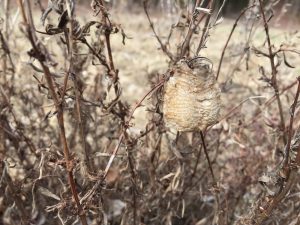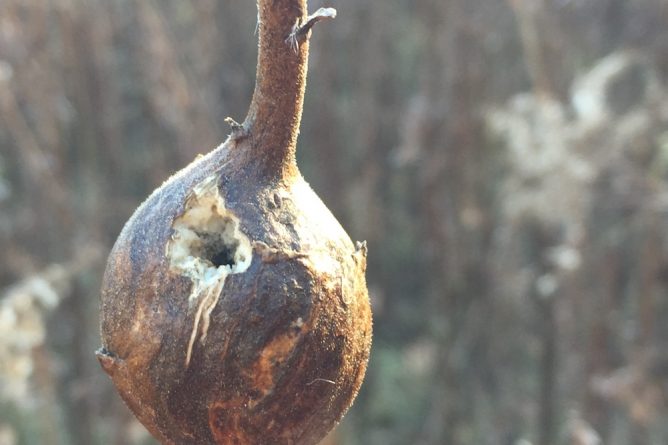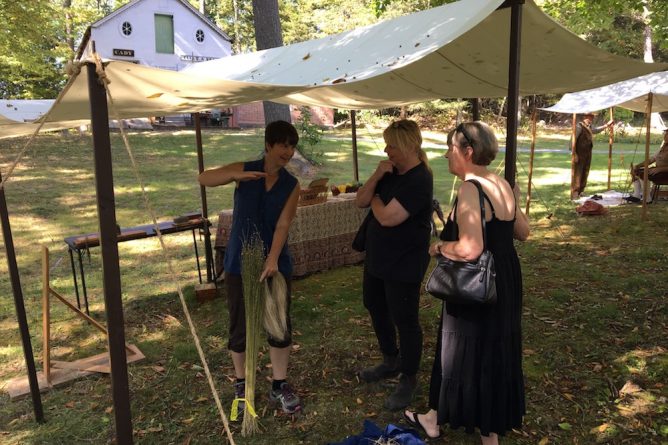In June the flax was happily growing. By June 2nd seedlings were emerging. I was excited and took a lot of pictures. To identify the beds, I wrote my nickname for each type on a stake at the corner of the bed. The name is on the left and the photo of that type of flax is on the right of each pair of images:
Flax 2018-What Happened in May
I usually aim to plant flax in mid-April. Sometimes it is snowy at that time, so I have to wait. Sometimes I just don’t get everything organized in time. This year was a case of the latter. Well, it did snow during my vacation week in April, but that wasn’t the main obstacle. It took me a long time to winnow all my seed and to figure out what I wanted to do this season. Long story short, I didn’t plant my flax until the Monday of Memorial Day Weekend, May 28th.
Here’s what the site looked like on May 28th:
I grew flax at Amethyst Farm again this year. I am more grateful than I can say to Bernard at Amethyst Farm for generously sharing his land and to Ryan at Many Hands Farm Corps for working me into his crop rotation and tilling the site this spring. I am also grateful for their encouragement and advice every time I have encountered difficulties. Continue reading “Flax 2018-What Happened in May”
Swamp Milkweed Update
Ever since I planted my swamp milkweed (Asclepias incarnata) in 2014, it has suffered from yellow aphids. I thought I had mentioned this problem in an earlier post. However, when I went back to look for it, I found that comment was buried in a lot of other information about praying mantises and pesky garden bugs. So, here’s a post dedicated to my swamp milkweed and how it’s doing this summer.
There are many dimensions to the life of any plant, so I divided this up into sub-categories.
Yellow Aphids
I did a better job this year checking the plants for aphids. For most of the summer I didn’t notice any, and the plants seemed happy. I had been worried they wouldn’t come back because some of the plants were very badly affected by yellow aphids last summer. They had sad withered stalks and gave up the ghost early in the season. Last week, I noticed aphids for the first time, and promptly washed them off with water. I am used to squishing bugs, and tiny ones like aphids don’t gross me out too much. So, I employed a “rinse and squish” method of physical removal.
Here are yellow aphids on the base of the stalks, close to the ground:
Grow Flax Everywhere
In 2015, my flax and linen study group got 29 types of different fiber flax seed from the USDA. I’ve been doing my best to keep them isolated as I grow them, though I’m down to 12 types now that I’ve been able to keep going. Many earlier blog posts document my successes and failures with this project thus far.
My “beer bottle” method for removing flax seeds has some draw-backs. Hunching over like Gollum while I work is one of them. I have specific goals when I’m working with these seeds, which lead to specific practices that have (hopefully) specific outcomes. Namely, I am trying to keep the different varieties of flax isolated so that I can grow them out and increase the quantity of seed that I have from each type. When I’m taking the seeds off, I make an effort to keep the types separate. Continue reading “Grow Flax Everywhere”
Rippling and Winnowing Flax Seed
Over the years that I’ve been growing flax, I have written several verses of a silly, imaginary song. Each verse tells you about something you shouldn’t do, inspired by my own trials and failures. One verse goes like this: “Don’t store your flax with the seeds on/For it will attract lots of mice./They’ll get fat on the seeds/And leave lots of debris/Don’t store your flax with the seeds on.” Yes, this is based on a true story.
Despite this good advice to myself, it often takes several months or even years before I get around to the next step in the process. On April 20th, in anticipation of my 2018 growing season, I finally finished removing the seeds from the flax I grew in 2016. Continue reading “Rippling and Winnowing Flax Seed”
FIBERuary 2018
Since it has been so many months since I last posted, I am trying to catch up in chronological order. My last series of posts was from December 2017. This one is from February 2018.
Thanks to the efforts of Carole Adams of Whispering Pines Farm, and Liz Sorenson of Sheep and Shawl, among others, we have a new local tradition here in Western MA called FIBERuary. During the month of February, Carole features local fiber farmers and fiber artists on the FIBERuary blog, and Liz hosts a speaker series at her shop in South Deerfield, MA. (12/31/2023 Edited: Carole is sorely missed here in Western MA, may she rest in peace. Here’s a link to her old blog where you can read up about her adventurous life. Sheep and Shawl is now a virtual storefront on Etsy, but you can still take classes with Liz at Hill Institute.)
I have been a contributor to the FIBERuary blog on a couple occasions, and a speaker at their speaker series. In these hot and humid days of August, I decided to share an expanded version of the post I wrote this February. It’s about one of my favorite dye plants, weld: Continue reading “FIBERuary 2018”
Icy Queen Anne’s Lace
On Christmas Eve my family went sledding on a snow, icy hill in New Hampshire. My sister Denise captured these beautiful images of Queen Anne’s Lace encased in ice after an ice storm.
You can see the seed heads at the tops of the plant stalks, still standing despite the weather. Here are a couple close-ups:
Praying Mantis Egg Cases
Here’s another reflection on the fascinating intricacies of plant-insect relationships.
Way back in April, I was prepping some beds to plant woad at our Amethyst Brook community garden plot. I noticed this egg case on a hyssop plant:
I was pretty sure it was a praying mantis egg case. Several year ago, a parent in my class at school brought us a praying mantis egg case to observe. She told us to leave it in a glass jar in the garden shed all winter. In the spring when it started to warm up, we brought the jar into the classroom. Continue reading “Praying Mantis Egg Cases”
Goldenrod Ball Galls
One of the things I love about dyeing with plants is that plants are amazing and awe-inspiring in so many other ways, too. First of all, they create their own food from energy from the sun, and provide all of us oxygen-breathers and plant-consumers with life and sustenance. For that alone I am so grateful. And that’s just the tip of the iceberg of amazing things about plants!
They are an integral part of complex inter-relationships that are not always obvious at my human eye level. I catch glimpses of some of these sometimes while I walk in the fields and woods, or when I garden. It makes me realize how much I don’t know about the intricate network of relationships between plants, animals, and microorganisms that are going on around me all the time. Continue reading “Goldenrod Ball Galls”
Historic Eastfield Village 2017
On Saturday September 23rd, I demonstrated the flax-to-linen process at Historic Eastfield Village’s Founder’s Day celebration. It was a lovely day! We had a heat wave later that week, but under the oak trees that day it was pleasantly cool and shady.
I brought dried flax stalks with the seeds on, retted flax, and all the tools to break, scutch, and hetchel the fibers. I also had some commercial linen yarns that I dyed with madder, weld, woad, and black walnut.
Historic Eastfield Village is a very interesting place. You can read more about their history, buildings, and classes on their website. Last year, I attended Founders Day with Lisa Bertoldi, on the invitation of Niel DeMarino of the Georgian Kitchen, whom we had met at the Flax and Linen Symposium in August 2016. Continue reading “Historic Eastfield Village 2017”


